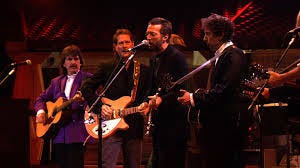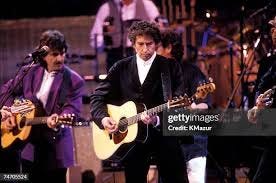We’re not sure precisely where stuff comes from that pops up now and then on YouTube but sometimes, there can be things that really catch your eye.
For reasons I’m not quite sure I can logically explain, I took a half-hour out of my afternoon to watch the 36:29 of the 1992 rehearsal footage of “My Back Pages” which would prove to be the highlight performance at the Bob Dylan 30th Anniversary Celebration at Madison Square Garden. Watched it a couple of times, actually.
The song was the highlight performance that you could later see on MTV and VH-1 and everywhere else. It was also a performance where Uncle Bob went back into a recording studio the day after the concert (my guess) and turned in a respectful, on-tune vocal on one of his most ambitious, historic and generally underplayed classic hits instead of the sheep-pleating version we heard on the original broadcast. Which was a proper corrective.


Thematically, they could hardly have picked a more appropriate song for the evening which featured just about everybody who had even a tangential connection to Dylan coming out performing a few of his songs. Johnny Cash, John Mellencamp, The Band and so many others, it was dazzling. They were going through Bob Dylan’s back pages, after all.
And on this particular number you had Eric Clapton and Neil Young swapping leads, George Harrison, Tom Petty and Roger McGuinn trading verses (and there were plenty of ‘em), you even saw guitarist Steve Cropper in the background of the background on this rehearsal. G.E. Smith was everywhere at once, evidently coordinating everybody and everything.
On the night of the show, it was a dramatic and scintillating performance, Clapton and Young carving out impeccable, distinctive guitar solos, all the big shots getting their turn to sing a verse. It turned out to be the perfect Dylan song for that kind of showcase, even if you didn’t completely understand the lyric or why it was so pivotal in his development as a songwriter.
Back in the film of the rehearsal in the middle of all those guitars, was, of course, the author of the song, casually dressed in a baggy short-sleeved white shirt, absently strumming on an acoustic guitar, occasionally offering a comment to one guitar hero or another but pretty much just standing there. Everyone around him worked out what verses they were going to sing or their leads or whatever, they seemed very purposeful, on a mission.
As we certainly understand by now, Bob operates on Bob’s frequency and it was fun to see him, just fiddling around while everyone around him wanted to get this exactly right. This was a crucially important song he’d written 28 years earlier for “Another Side Of Bob Dylan,” a transitional album that was recorded in a single night (or so the story goes). It was as if now, that song didn’t mean anything more to him than “Peggy Day” or “Wiggle Wiggle” or “Man Gave Names To All The Animals” (my personal Dylan nadir!)
It was fun to see — and hear — Eric and Neil work out their guitar leads which would absolutely sparkle the night of the concert. To see all these guitar heroes and generational stars just trying to work together to give a Bob Dylan song the proper showcase, it was a lot more fun for me to watch than I would have imagined. Maybe it will be fun for you, too.
As for the show itself, it was a memorable night. There was, always, some controversy, this time over Sinead O’Connor’s behavior and The Band, sans Robbie Robertson, seemed to be a bit of an afterthought in the night’s set, somewhat contrary to their importance in Dylan’s career. But if you’re a Dylan fan, how could you not like hearing a whole night of his music played by some of music’s finest and most enduring talents?
What may have been somewhat overlooked was the significance of this particular song historically speaking, because it was where Dylan explained — in verse — that he was moving away from protest or “finger-pointin’ songs” as he called them once and was moving into different spheres, operating on a different level, going where his muse led him. no matter what.
Lyrically speaking, “My Back Pages” was Bob stretching his writing skills as far as he could at that point. Some lines are a bit strained and awkward, as if he’s reaching so high and so far, he couldn’t quite get there.
But the refrain, as effective and potent as any he would ever come up with, was a killer — “I was so much older then, I’m younger than that now.”
The opening verse, which reportedly was a description of a lightning storm, is a bit of a reach, isn’t it?
“Crimson flames tied through my ears, rolling high and mighty trapped,” he sang. “Pounced with fire on flaming roads, using ideas as my maps. “We’ll meet on edges, soon” said I, proud ‘neath heated brow. Ah, but I was so much older then, I’m younger than that now.”
From there, things got a bit clearer. In Verse Two, he criticizes himself for telling “lies that life is black and white” in those finger-pointing songs. In Verse Three, he talks about “phony jealousy” and “memorizing politics of ancient history.” In Verse Four, he talks about liberty and equality as being two separate things, something he says he understands now.
“A self-ordained professor’s tongue, too serious to fool, spouted out that liberty is just equality in school. “Equality,” I spoke the word as if a wedding vow.” Ah, but I was so much older then, I’m younger than that now.”
And then, Bob’s verse — we assume he got to pick which one he would sing — and that lovely image of “confusion boats, mutiny from stern to bow.” Good thing he redid it. “Fearing not I’d become my enemy in the instance that I preach.” Bob is looking deeply inside himself, his work so far, what he’s done and looks ahead to what he wants to do, now that all this is behind him. His preaching days, he says, are over. (They weren’t, of course.)
Then that ol’ Beatle, George Harrison gets to put a capper on things with Bob’s closing verse where he tells us he understands things differently NOW
“My guard stood hard when abstract threats, too noble to neglect, deceived me into thinking I had something to protect. Good and bad, I define these terms, quite clear, no doubt somehow. Ah, but I was so much older then, I’m younger than that now.”
Bob was evidently very proud of the song and the version you see on stage at Newport in 1964 on “The Other Side Of The Mirror” is funny; he’s never been more open or loving and if he’s a little tipsy, you also got the sense that he could see he was at a tipping point. He was going to go somewhere different in his music. As he saw it, he had no choice.
HERE’S THE REHEARSAL OF “MY BACK PAGES”
The rehearsal for “My Back Pages” for Bob Dylan’s 30th Anniversary Celebration
When the song was released on video. Bob’s foghorn vocal was overdubbed, fortunately.
If you really want to get a kick out of Bob singing this song, possibly for the first time on stage, check out Murray Lerner’s “The Other Side Of The Mirror,” a wonderful DVD of Dylan’s Newport performances which includes what seems to be a rather drunken, joyous Bob, trying to wind through “My Back Pages.” And the audience loves him. And, remarkably, he loves them back. We’d never see that again.
I tried but couldn’t find it online but did see a very nice clip of “Mr. Tambourine Man” from Newport a year later, which he played as an encore after being booed after his three electric songs. If you look very closely, you can see a tear on Bob’s cheek.
John Nogowski is the author of “Bob Dylan: A Descriptive, Critical Discography 1961-2022,” available now on Amazon or from McFarland and Co..




I like the Byrds’ version too.
Remember that show. Grateful Dead fall tour was canceled. Tried to get tickets to Bobfest but got shut out. Was very thankful that it was broadcast on PBS. For me, Foot of Pride sung by Lou Reed was a highlight